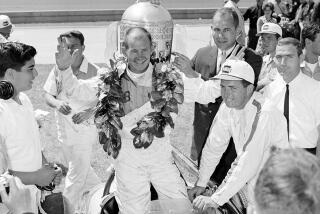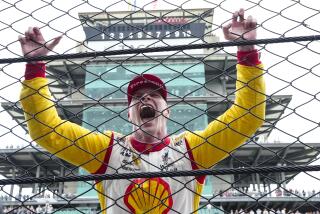Penske’s Cars Can’t Keep Up in Qualifying : Auto racing: After dominating seven of nine Indy races, three-man team starts today’s Marlboro 500 in back rows.
BROOKLYN, Mich. — The three-car Penske juggernaut, which has dominated seven of nine Indy car races this season, might hit a snag here today at, of all places, Roger Penske’s own track, Michigan International Speedway.
On the two-mile banked oval where Al Unser Jr., Emerson Fittipaldi and Paul Tracy tested and developed the Mercedes-Benz version of the Ilmor Indy car engine that prevailed at the Indianapolis 500, cars powered by Ford-Cosworth V8 engines swept the front row for today’s Marlboro 500.
Britain’s Nigel Mansell, defending series and race champion, took the pole Saturday with a qualifying lap of 233.738 m.p.h. It was enough to justify Michigan’s reputation as the “world’s fastest racetrack” but shy of Mario Andretti’s closed-course world record of 234.275 set here last year--and also shy of an unofficial lap of 235.639 Mansell ran earlier in the day.
Ford drivers Raul Boesel, 232.672, and Michael Andretti, 232.543, will start alongside Mansell. Andretti, with victories in Australia and Toronto, is the only non-Penske driver to win this season.
To further compound Penske’s problem, two more Ford-powered drivers--Robby Gordon and Mario Andretti--and Ilmor-powered Stefan Johansson filled the second row. Fittipaldi, at 228.710, was the fastest of the Penskes, good for only seventh position in the 28-car field.
It was quite a turnabout from previous races in which Penske drivers twice finished 1-2-3, have led 935 out of a possible 1,114 laps and have had at least one driver among the top three in every race.
Gordon, who is battling Michael Andretti for best-in-class honors among non-Penske drivers, said of the previous races: “Sometimes the speed difference has made it seem like they were in Indy cars and we were in Super Vees.”
Penske, whose cars have won 10 of the last 26 Indy 500s, raised a few eyebrows in the racing world when he signed Unser last fall and announced he would run a three-driver team. Although three-driver teams have been commonplace for the Indy 500, they have proved to be too difficult to maintain over a full season.
Many two-car teams have been torn apart by jealousies and bickering among drivers and crew members. Every driver who fails to win fears he has not been given the same treatment as the driver who does.
Amazingly, Penske has avoided such controversies.
“I thought it might be a problem when Al joined the team, but right from the start, Roger (Penske) and (team manager) Charlie Sprague made it definite that we would all get the same treatment,” Tracy said. “When one of us finds a new part that seems to work better, the three of us wait until all three cars can have it before it is used in a race.
“It has really helped in testing. One driver can only do so much, but with three drivers we got in three times the amount of testing. I think that was the real reason we did so well right off the start, we had tested so much to maximize the car before the season started.”
Gary Denton, Unser’s electronics engineer, said it is not unusual to see Unser, Fittipaldi and Tracy sitting around studying a network of telemetry that monitors and records forward and lateral G-forces, oil pressure, temperatures, fuel mix, throttle response, braking, suspension travel, engine r.p.m.s and other data.
Drivers are most interested in steering wheel angles and throttle positions.
“The data allows them to see how far they drove into a turn, when they upshifted or downshifted, and whether they were running flat out,” Denton said.
It is a long way from the days when Penske had a light put on top of his cars and rigged a sensor on the accelerator. The principle was simple: When the light was on, the driver had it flat. Whenever he lifted, the light went out.
Still, Penske cars have won only two of 13 Michigan 500s.
Today, despite earlier successes, does not figure to change although Michigan races often take on more the character of a rodeo than a motor car race.
“This is a wild race track,” Mansell said. “All the way around the circuit, it is difficult and awfully demanding. At this track, you are always attacking, overtaking, but there are places out there where you can’t see anything for the bumping and bouncing. My philosophy has been to not try and look too closely, it might be too frightening.”
The Ford advantage comes from a different power range that delivers more horsepower than the Ilmors or the Hondas driven by Bobby Rahal and Mike Groff.
“Michigan is the only track where you go flat out all the way around,” Unser said. “The Ilmor is more efficient on a track where you either lift or brake or slow down in the turns, which gives us an advantage on the street and road courses and even at Indy where you lift slightly.”
More to Read
Go beyond the scoreboard
Get the latest on L.A.'s teams in the daily Sports Report newsletter.
You may occasionally receive promotional content from the Los Angeles Times.










